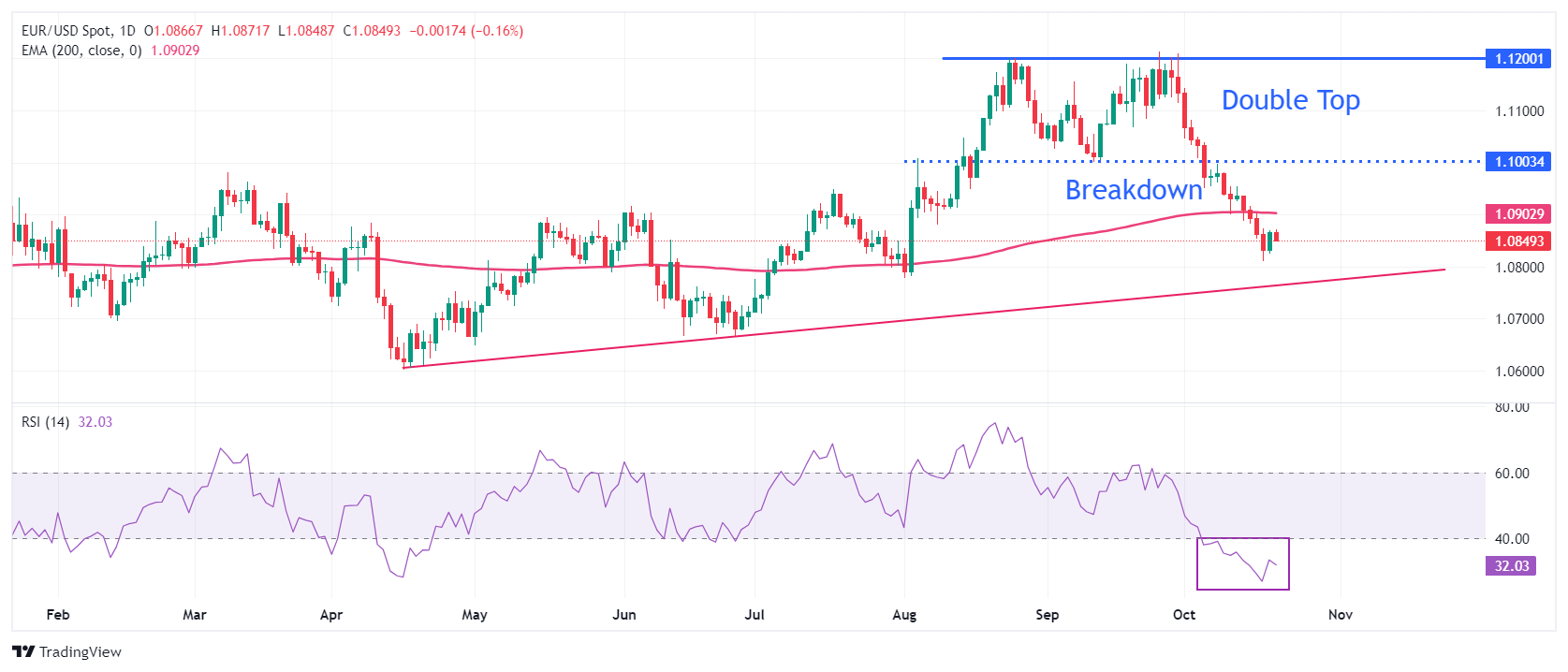EUR/USD skates on thin ice as ECB dovish bets swell
- EUR/USD holds 1.0800, though its outlook remains uncertain on ECB dovish bets.
- The Eurozone's economic growth is expected to remain modest.
- The US Dollar will be influenced by market expectations for US presidential elections.
EUR/USD struggles to extend Friday’s recovery above the immediate resistance of 1.0870 in Monday’s North American session. The major currency pair could retreat to its 11-week low near 1.0800 set on Thursday as investors expect the European Central Bank (ECB) to continue easing interest rates further.
With faltering Eurozone economic growth and the inflationary pressures below the bank’s target of 2%, investors expect the ECB to cut its borrowing rates again in December.
ECB policymaker and Estonian central bank Governor Madis Müller argued on Friday that the expectations of modest economic growth would probably tame price pressures further. The confidence of market participants for inflation remaining contained strengthened after the ECB’s own Survey of Professional Forecasters downwardly revised price growth to 1.9% for next year from 2% anticipated a quarter ago.
In Monday's early European session, Lithuanian central bank governor and ECB Governing Council member Gediminas Šimkus delivered a dovish interest rate guidance. Šimkus said, "If the disinflation processes get entrenched it's possible that rates will be lower than the natural level."
For more clarity on the interest rate outlook, investors will pay close attention to the two-day ECB President Christine Lagarde’s speech, starting on Tuesday. In her press conference after the central bank’s 25 basis points (bps) rate cut decision on Thursday, Lagarde didn’t offer a specific interest rate path and said decisions would be based on the incoming data.
Daily digest market movers: EUR/USD walks on thin rope as traders brace for US presidential elections
- EUR/USD will likely resume its downside journey as the US Dollar (USD) is expected to extend its upside after a minor technical correction on Friday. The US Dollar Index (DXY), which tracks the Greenback’s value against six major currencies, posted a fresh 11-week high last week near 104.00 on multiple tailwinds.
- The outlook of the Greenback remains firm as traders are confident that the Federal Reserve (Fed) will pursue a gradual interest rate cut path. According to the CME FedWatch tool, 30-day Federal Funds futures pricing data shows that the market expects 50 basis points (bps) decline in interest rates in the remaining year, suggesting that the Fed will cut its borrowing rates by 25 bps in November and December.
- Market expectations for the Fed opting for a less aggressive policy-easing cycle strengthened after a slew of United States (US) economic data for September pointed to economic resilience. For more cues on the economic outlook, investors will keep an eye on the preliminary S&P Global Purchasing Managers’ Index (PMI) data for October, which will be published on Thursday.
- Meanwhile, the fate of the US Dollar could be highly volatile as US presidential elections are around the corner. The latest national polls have shown Democratic candidate and US Vice President Kamala Harrish has the upper hand over Republican nominee and former US President Donald Trump.
Technical Analysis: EUR/USD holds key support of 1.0800
EUR/USD holds the immediate support of 1.0800 in North American trading hours. However, the outlook of the major currency pair remains uncertain as it trades below the 200-day Exponential Moving Average (EMA), which trades around 1.0900.
The downside move in the shared currency pair started after a breakdown of a Double Top formation on a daily timeframe below the September 11 low at around 1.1000, which resulted in a bearish reversal.
The 14-day Relative Strength Index (RSI) dives below 30.00, indicating a strong bearish momentum. However, a recovery move remains on the cards as conditions turn oversold.
On the downside, the major could find support near the upward-sloping trendline at 1.0750, which is plotted from the October 3 low around 1.0450. Meanwhile, the 200-day EMA and the psychological figure of 1.1000 will be the key resistance for the pair.
ECB FAQs
The European Central Bank (ECB) in Frankfurt, Germany, is the reserve bank for the Eurozone. The ECB sets interest rates and manages monetary policy for the region. The ECB primary mandate is to maintain price stability, which means keeping inflation at around 2%. Its primary tool for achieving this is by raising or lowering interest rates. Relatively high interest rates will usually result in a stronger Euro and vice versa. The ECB Governing Council makes monetary policy decisions at meetings held eight times a year. Decisions are made by heads of the Eurozone national banks and six permanent members, including the President of the ECB, Christine Lagarde.
In extreme situations, the European Central Bank can enact a policy tool called Quantitative Easing. QE is the process by which the ECB prints Euros and uses them to buy assets – usually government or corporate bonds – from banks and other financial institutions. QE usually results in a weaker Euro. QE is a last resort when simply lowering interest rates is unlikely to achieve the objective of price stability. The ECB used it during the Great Financial Crisis in 2009-11, in 2015 when inflation remained stubbornly low, as well as during the covid pandemic.
Quantitative tightening (QT) is the reverse of QE. It is undertaken after QE when an economic recovery is underway and inflation starts rising. Whilst in QE the European Central Bank (ECB) purchases government and corporate bonds from financial institutions to provide them with liquidity, in QT the ECB stops buying more bonds, and stops reinvesting the principal maturing on the bonds it already holds. It is usually positive (or bullish) for the Euro.
